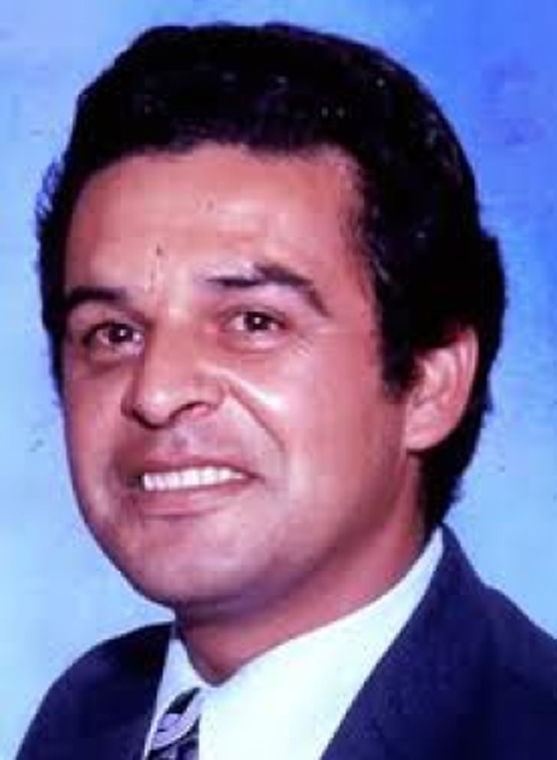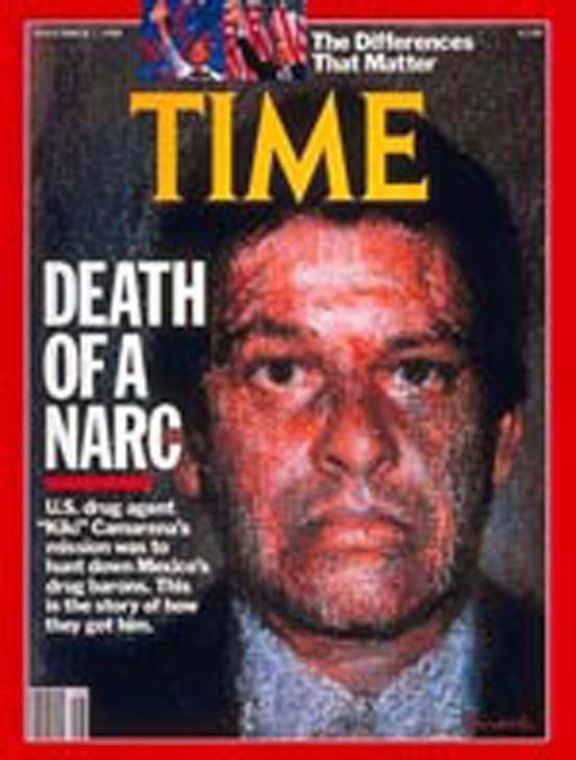Name Kiki Camarena | Spouse Mika Camarena (m. ?–1985) | |
 | ||
Nickname(s) "Kike" (Spanish), "Kiki" (English) Years of service 1972–1974 (U.S. Marine Corps) Children Enrique Camarena Jr., Daniel Camarena, Erik Camarena Parents Daniel Camarena, Dora Salazar-Camarena Similar People Rafael Caro Quintero, Ernesto Fonseca Carrillo, Miguel Ángel Félix Gallardo | ||
Assassinated February 9, 1985, Mexico | ||
Narcos kiki camarena scene
Enrique S. "Kiki" Camarena Salazar (July 26, 1947 – February 9, 1985) was a Mexican-born American undercover agent for the United States Drug Enforcement Administration (DEA) who was abducted on February 7, 1985, and then tortured and murdered, while on assignment in Mexico. Camarena's nickname was "Kike" in Spanish, and "Kiki" in English.
Contents
- Narcos kiki camarena scene
- Narcos Mexicos Michael Pena reveals the advice Kiki Camarenas widow gave him
- Early life and education
- Abduction and murder
- Investigation
- Legacy
- Personal life
- Film
- Publications
- Television
- References

Narcos: Mexico’s Michael Pena reveals the advice Kiki Camarena’s widow gave him
Early life and education
From 1973 to 1975, Camarena served in the United States Marine Corps, after which he joined the DEA, at their Calexico, California, office. In 1977, Camarena moved to the agency's Fresno office, and in 1981, he was assigned to their Guadalajara office in Mexico. Camarena had also worked as a firefighter and police investigator before joining the DEA in Calexico.
Abduction and murder

In 1984, acting on information from Camarena, 450 Mexican soldiers backed by helicopters destroyed a 1,000-hectare (≈2,500 acres) marijuana plantation with an estimated annual production of $8 billion known as "Rancho Búfalo". Camarena, who had been identified as the source of the leak, was abducted in broad daylight on February 7, 1985, by corrupt police officers working for drug lord Miguel Ángel Félix Gallardo. Camarena was tortured at Gallardo's ranch over a 30-hour period, then murdered. His skull, jaw, nose, cheekbones and windpipe were crushed, his ribs were broken, and a hole was drilled into his head with a power drill. He had been injected with amphetamines and other drugs, most likely to ensure that he remained conscious while being tortured. Camarena's body was found in a rural area outside the small town of La Angostura, in the state of Michoacán, on March 5, 1985.
Investigation

Camarena's torture and murder prompted a swift reaction from the U.S. Drug Enforcement Administration (DEA) and launched Operation Leyenda, the largest DEA homicide investigation ever undertaken. A special unit was dispatched to coordinate the investigation in Mexico, where corrupt officials were implicated. Investigators soon identified Miguel Ángel Félix Gallardo and his two close associates, Ernesto Fonseca Carrillo and Rafael Caro Quintero, as the primary suspects in the kidnapping. Under pressure from the U.S. government, Mexican President Miguel de la Madrid's quickly apprehended Fonseca and Quintero but Félix Gallardo still enjoyed political protection.

The United States government pursued a lengthy investigation of Camarena's murder. Due to the difficulty of extraditing Mexican citizens, the DEA went as far as to detain two suspects, Humberto Álvarez Machaín, the physician who allegedly prolonged Camarena's life so the torture could continue, and Javier Vásquez Velasco; both were taken by bounty hunters into the United States.
Despite vigorous protests from the Mexican government, Álvarez was brought to trial in Los Angeles in 1992. After presentation of the government's case, the judge ruled that there was insufficient evidence to support a guilty verdict, and charges were dropped. Álvarez subsequently initiated a civil suit against the U.S. government, charging that his arrest had breached the U.S.-Mexico extradition treaty. The case eventually reached the U.S. Supreme Court, which ruled that Álvarez was not entitled to relief. The four other defendants, Vásquez Velasco, Juan Ramón Matta-Ballesteros, Juan José Bernabé Ramírez, and Rubén Zuno Arce (a relative of former President Luis Echeverría), were tried and found guilty of Camarena's kidnapping.
Arce had known ties to corrupt Mexican officials, and Mexican officials were implicated in covering up the murder. Mexican police had destroyed evidence on Camarena's body.
In October 2013, two former federal agents and a self-proclaimed ex-CIA contractor told an American television network that CIA operatives were involved in Camarena's kidnapping and murder, because he was a threat to the agency's drug operations in Mexico. According to the three men, the CIA was collaborating with drug traffickers moving cocaine and marijuana to the United States, and using its share of the profits to finance Nicaraguan Contra rebels attempting to overthrow Nicaragua's Sandinista government. A CIA spokesman responded that “it's ridiculous to suggest that the CIA had anything to do with the murder of a U.S. federal agent or the escape of his killer.”
Legacy
Personal life
Camarena is survived by his wife Mika and their three sons.
Film
Several movies about Camarena were produced in Mexico, and he is referenced in others. For example:
